What is a Corporate-Level Strategy?
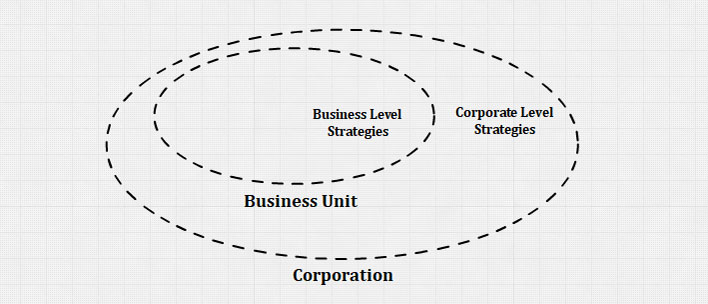
Corporate strategy is about the choice of direction for a firm as a whole and the management of its business or product portfolio. In large corporations, corporate strategy is concerned with managing various product lines and business units for maximum value.
Corporate strategy must decide the flow of financial and other resources from and to the organization’s products lines and business units. Through these coordinating devices, a company transfer resources and capabilities from one unit to another to obtain synergy among numerous product lines and business units.
A corporation must use its corporate strategy to coordinate the different business strategies of its product lines or business units so that corporation can succeed as a whole. In turn, each product line or business unit can have its own competitive or cooperative strategy that it uses to obtain its own competitive advantage in the marketplace.
Corporate Strategy in Value Creation
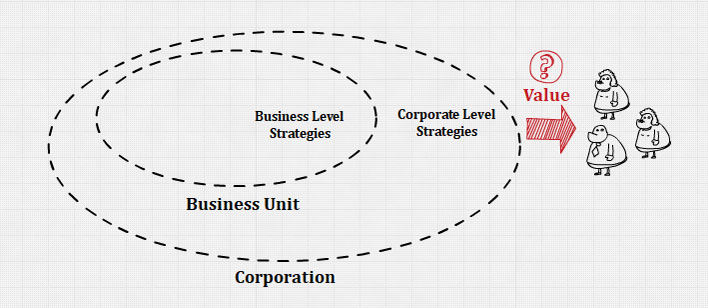
A corporate-level strategy is expected to help the firm earn above-average returns by creating value. However, few corporate-level strategies actually create value.
Realizing value through a corporate strategy can be achieved, but it is challenging to do so. A corporate-level strategy’s value is ultimately determined by the degree to which the businesses in the portfolio are worth more under the management of the company than they would be under any other ownership.
Thus, an effective corporate-level strategy creates, across all of a firm’s businesses, aggregate returns that exceed what those returns would be without the strategy and contributes to the firm’s strategic competitiveness and its ability to earn above-average returns.
Corporate Strategy vs. Business Strategy
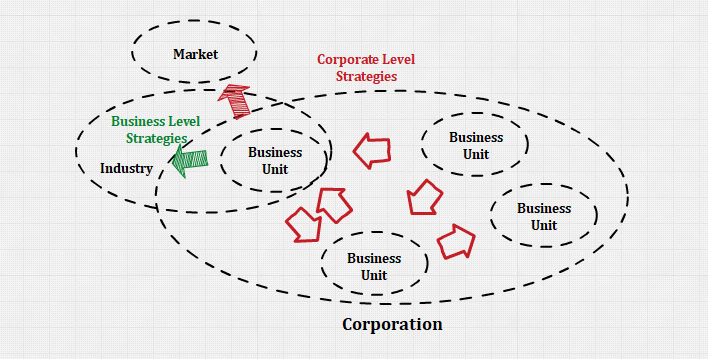
Because a diversified firm operates in several different and unique product markets and likely in several businesses, it forms two types of strategies: corporate-level (company-wide) and business-level (competitive).
For a diversified company, a corporate-level strategy is concerned with two key issues: (1) in what product markets and businesses the firm should compete and (2) how corporate headquarters should manage those businesses. A business-level strategy must be selected for each of those businesses in which the firm has decided to compete.
While business-level strategies concentrate on firms competing in a single industry or product market, firms use corporate-level strategies to diversify their operations from a single business competing in a single market into several product markets and then into several businesses.
Thus, a corporate-level strategy specifies actions a firm takes to gain a competitive advantage by selecting and managing a group of different businesses competing in different product markets.
The 3 Key Issues in Corporate Strategy
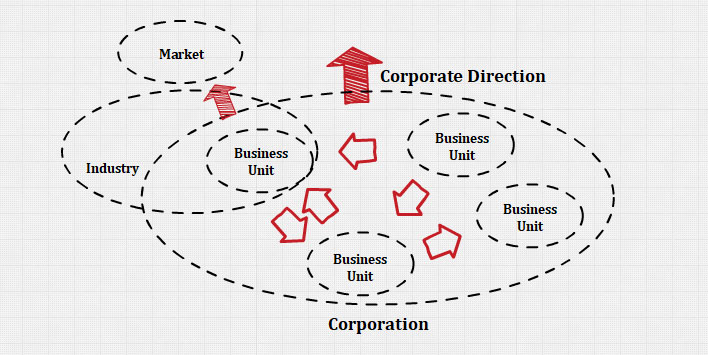
Corporate strategy deals with 3 key issues facing the corporation as a whole.
The first issue is directional strategy, which is the organization’s overall orientation toward growth, stability, or retrenchment.
The second issue is portfolio analysis, which is the analysis of industries or markets in which the firm competes through its products and business units.
The third issue is corporate parenting, which is the structure in which management coordinates activities, transfers resources, and cultivates capabilities among product lines and business units.
Key Issue 1: Directional Strategy
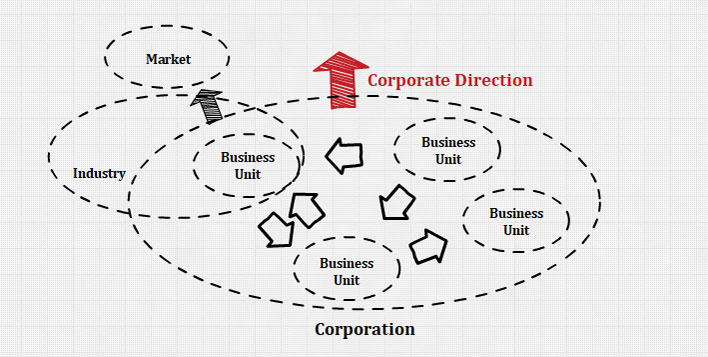
Types of Directional Strategy
A corporation directional strategy is composed of 3 general orientations.
The first direction is a growth strategy, which expands the company’s activities. The second direction is stability strategy, which makes no change to the company’s current activities. Finally, the third direction is a retrenchment strategy, which reduces the company level of activities.
Industry Selection in Directional Strategy
During consideration of directional strategy, a corporation has several options when choosing which industries to compete in, with regard to growth, stability, or retrenchment.
First, a company can concentrate on only one industry and focus its activities on developing business-level strategies to improve its competitive position in that industry.
Second, a company may decide to enter new industries in adjacent stages of the industry value chain by pursuing a strategy of vertical integration, which means it either begins to make its own inputs and/or sell its own products.
Third, a company can choose to enter new industries that may or may not be connected to its existing industry by pursuing a strategy of diversification.
Finally, a company may choose to exit businesses and industries to increase its long-run profitability and to shrink the boundaries of the organization by restructuring and downsizing its activities.
Key Issue 2: Portfolio Analysis
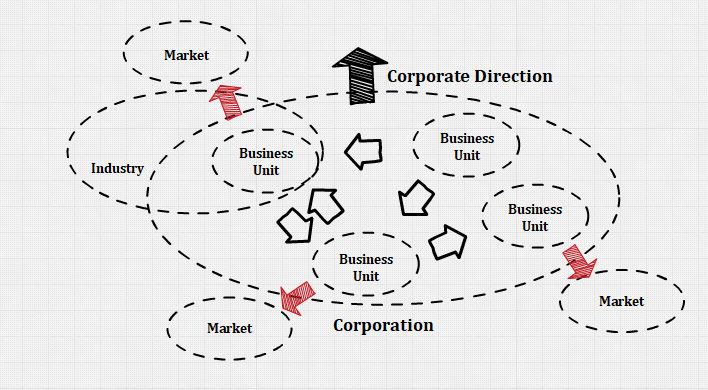
What is Portfolio Analysis?
Portfolio analysis is a process that helps executives assess their firms’ prospects for success within each of its industries, offers suggestions about what to do within each industry, and provides ideas for how to allocate resources across industries.
Portfolio analysis puts corporate headquarters into the role of an internal banker. Top management views its product lines and business units as a series of investments from which it expects a profitable return.
Portfolio answers the following 2 questions during corporate-level strategy formulation.
Question 1: how much time and money should be spent on the best product lines and business units to ensure that they continue to succeed?
Question 2: how much time and money should be spent developing new costly products, most of which will never succeed?
Advantages and Limitations of Portfolio Analysis
Portfolio analysis has several advantages.
They are as follows: (1) it encourages top management to evaluate each of the corporation business individually, set objectives, and allocate resources for each; (2) it stimulates the use of externally oriented data to supplement management judgement; and (3) it raises the issue of cash-flow availability for use in expansion and growth.
Portfolio analysis also has its limitations.
They are as follows: (1) it is difficult to define product/market segments; (2) the use of standard strategies that can miss opportunities or be impractical; (3) it provides positions that are based on subjective judgment; and (4) it is not always clear what makes an industry attractive or where a product is in its life cycle.
Strategic Alliance Portfolio Management
Just as product lines or business units, strategic alliances can also be viewed as a portfolio of investments of money, time, and energy. Business units are primarily responsible for managing groups of strategic alliances. However, the decisions sometimes escalate to the corporate level.
Top management must dynamically manage these relationships which can heavily influence corporate competitiveness.
There are 4 primary tasks that must be managed for a successful strategic alliance portfolio.
The first task is to develop and implement a portfolio strategy for each business and a corporate policy for managing all the alliances of the company. Strategic alliance portfolio strategy is determined by business units.
A corporate policy consists of general rules concerning when, how, and with whom to cooperate. The task of corporate policy is to strategically align all of the corporation alliance activities with corporate strategy and corporate values.
The second task is to monitor the strategic alliance portfolio in terms of implementing business unit strategies and corporate strategy and policies. Each alliance is measured in terms of achievement of objectives, financial measures, and the overall relationship.
The third task is to coordinate the portfolio to obtain synergies and avoid conflicts among alliances. The interdependencies among alliances within a business unit are usually greater than among different businesses, thus the need for coordination is greater at the business level than at the corporate level.
The need for coordination increases as the number of alliances in one business unit and the company as a whole increase, the average number of partners per alliance increases, and/or the overlap of the alliance increases.
The fourth task is to establish an alliance management system to support other tasks of multi-alliance management. This infrastructure consists of formalized processes, standardized tools, and specialized organizational units. In other corporations, specialized positions for alliance management were created at both the corporate and business unit levels or only at the business unit level.
Most corporations prefer a system in which the corporate level provides the methods and tools to support alliances centrally but decentralizes day-to-day alliance management to the business units.
Key Issue 3: Corporate Parenting
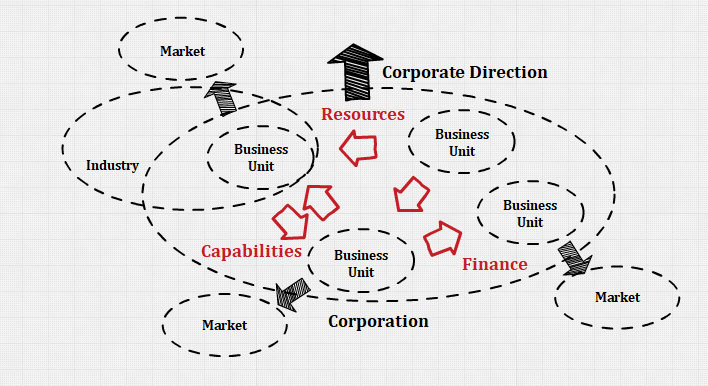
What is Corporate Parenting?
Corporate parenting views a corporation in terms of resources and capabilities that can be used to build business unit value as well as generate synergies across business units.
Portfolio analysis typically attempts to answer these questions by examining the attractiveness of various industries and by managing business units for cash flow. Therefore, unlike portfolio analysis which focuses mainly on viewing matters financially, corporate parenting looks at the organization more in terms of resources and capabilities.
Corporate parenting must address 2 crucial questions: (1) what businesses should the company own and why? (2) what organizational structure, management processes, and philosophy will generate superior performance from the business units?
Corporate parenting generates a corporate-level strategy by focusing on the core competencies of the parent corporation. If there is a good fit between the parent company’s skills and resources, then the company is more likely to create value.
The primary job of corporate headquarters is to obtain synergy among the business units by providing resources, transferring skills and capabilities among the units, and coordinating the activities of shared unit functions.
Development of Corporate Parenting
There are 3 analytical steps in searching for appropriate corporate parenting.
Step 1: examine each business unit in terms of its strategic factors. People in the business units probably already identified the strategic factors when they were generating business strategies for their units.
Step 2: examine each business unit in terms of areas in which performance can be improved.
The corporate parent could also transfer some people from one business unit who have the desired skills to another unit that is in need of those skills.
Step 3: analyze how well the parent corporation fits with the business unit. Corporate headquarters must be aware of its own strengths and weaknesses in terms of resources and capabilities.
The corporate parent must ask whether it has the characteristics that fit the parenting opportunities in each business unit. It must also ask whether there is a misfit between the parent’s characteristics and the critical success factors of each business unit.
Horizontal Strategy in Corporate Parenting
Horizontal strategy is a corporate-level strategy that cuts across business units to build synergy and to improve the competitive positions of one or more business units. When used to build synergy, it acts as a parenting strategy. When used to improve the competitive position of the business units, it acts as a corporate competitive strategy.
Although each business unit has primary responsibility for its own business strategy, it may sometimes need help from its corporate parent, especially if the competitor business unit is getting heavy financial support. Thus in this situation, corporate headquarters develop a horizontal strategy to coordinate various goals and strategies of related business units.
Sometimes large multi-business corporations compete against other large multi-business firms in a number of markets. Thus these firms compete with each other not only in one business unit but also in a number of business units. This phenomenon is called multipoint competition.
Resources
Further Reading
- Corporate Level Strategy: What It is Plus Examples (getsling.com)
- What Is a Corporate-Level Strategy? (indeed.com)
- Types of Corporate Level Strategies (yourarticlelibrary.com)
- Corporate Level Strategy- All you need to know (businessyield.com)
- What is Corporate Strategy? (corporatefinanceinstitute.com)
- Good Corporate Strategy – Everything You Need to Know (burniegroup.com)
- Corporate Strategy: The Four Key Components (cascade.app)
- Corporate Level Strategy (gaebler.com)
- Corporate-Level Strategies (granite.pressbooks.pub)
Related Concepts
- Corporate Directional Strategies
- Vertical Integration Growth Strategies
- Horizontal Integration Growth Strategies
- Basic Concepts of Diversification Strategies
References
- Hitt, M. A., Ireland, D. R., & Hoskisson, R. E. (2019). Strategic Management: Concepts and Cases: Competitiveness and Globalization (MindTap Course List) (13th ed.). Cengage Learning.
- Hill, C. W. L., & Jones, G. R. (2011). Essentials of Strategic Management (Available Titles CourseMate) (3rd ed.). Cengage Learning.
- Wheelen, T. L. (2021). Strategic Management and Business Policy: Toward Global Sustainability 13th (thirteenth) edition Text Only. Prentice Hall.